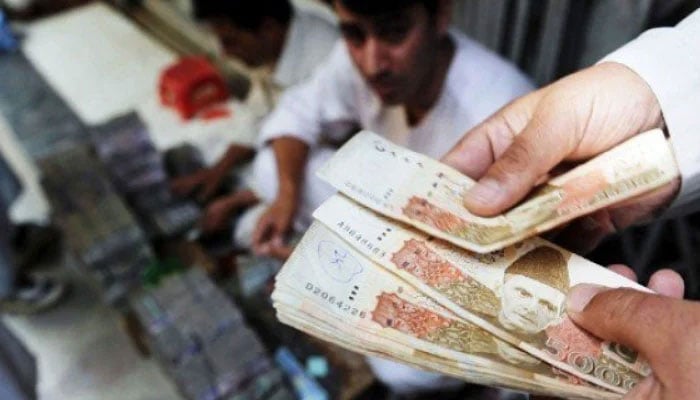Circular debt hits Rs2.31tr
Pakistan’s power sector circular debt for the fiscal year 2022-23 has reached Rs2.31 trillion
ISLAMABAD: Pakistan’s power sector circular debt for the fiscal year 2022-23 has reached Rs2.31 trillion.
This marks an increase of Rs57 billion compared to the previous fiscal year, when it stood at Rs2.253 trillion, despite the government’s efforts to adhere to the IMF’s directives, which included raising power tariffs and addressing sector inefficiencies.
However, by June 2023, the debt had decreased by Rs336 billion from its peak of Rs2.646 trillion in July 2023.
Independent experts have observed that while the recent decrease in circular debt was partly due to a significant base tariff hike of Rs7.9 per unit in July 2022, the underlying structural issues in the power sector remain unaddressed. These issues continue to burden loyal power consumers with substantial financial costs amounting to billions of rupees each month.
On average, the government imposed an additional charge of Rs19 per unit on consumers to retire and finance the growing debt. Despite these measures, the debt stock remained at the same level as a year ago, despite payments to power generators.
Payables to power producers surged by Rs83 billion to Rs1.434 trillion by June 2023, compared to Rs1.351 trillion recorded in June 2022. In July 2023, this figure reached Rs1.77 trillion, indicating that the government had repaid over Rs300 billion in just one month.
Meanwhile, state-owned generation companies saw their payables to fuel suppliers rise from Rs101 billion in FY22 to Rs111 billion in FY23.
The amount of debt parked in Power Holding Limited (PHL) was Rs800 billion in FY22, which was reduced by Rs35 billion in July 2023 to Rs765 billion. By the end of June (FY23), it remained at the same level (Rs765 billion).
The inefficiencies of power distribution companies, characterised by high losses and low bill recoveries, have placed a substantial burden on the financial health of the power sector. These shortcomings in power transmission and distribution have resulted in elevated energy prices and increased business costs. In FY23, DISCOs’ losses, inefficiencies, and non-recoveries of bills increased by 26.5 percent to Rs396 billion, up from Rs313 billion in FY22. The major increase came from low bill recoveries, which rose from Rs180 billion to Rs236 billion, while losses and inefficiencies increased from Rs133 billion to Rs160 billion.
Breaking down the additions to circular debt, Rs100 billion were attributed to interest payments to power producers on delayed payments, with the government owing Rs1.434 trillion to these generators.
Additionally, Rs43 billion were added to the circular debt due to interest payments to banks on the Rs765 billion parked in the power holding company. To address this issue, the government imposed a debt servicing surcharge of Rs3.23 per unit, passing on the cost of inefficiency to power consumers. Furthermore, Rs250 billion in the circular debt is due to delays in the recovery of generation costs through quarterly and monthly fuel charge adjustments. The ongoing dispute over subsidies between the government and K-Electric (KE) is one of several factors contributing to the mounting debt. As of June 2023, a substantial Rs346 billion remained unpaid to KE, exacerbating the revolving debt situation. The resolution of this conflict is crucial to stabilising the financial health of the energy sector.
-
 Everything You Need To Know About Macron’s Viral Glasses: Cost, Model, All Details Revealed
Everything You Need To Know About Macron’s Viral Glasses: Cost, Model, All Details Revealed -
 Elon Musk Warns Of AI ‘supersonic Tsunami’: What It Means For Future
Elon Musk Warns Of AI ‘supersonic Tsunami’: What It Means For Future -
 Why Victoria Beckham's Dance Video From Brooklyn's Wedding Won't Be Released
Why Victoria Beckham's Dance Video From Brooklyn's Wedding Won't Be Released -
 Prince Harry No Longer Focused On Healing Royal Family Feud?
Prince Harry No Longer Focused On Healing Royal Family Feud? -
 OpenAI Aims To Make AI A Daily Global Tool
OpenAI Aims To Make AI A Daily Global Tool -
 Will Andrew Receive Any Royal Treatment After Title, Royal Lodge Removal?
Will Andrew Receive Any Royal Treatment After Title, Royal Lodge Removal? -
 How Your Body 'suffers' In Back Pain And Simple Way To Fix It
How Your Body 'suffers' In Back Pain And Simple Way To Fix It -
 What Victoria Beckham Really Did At Brooklyn, Nicola’s Wedding Revealed
What Victoria Beckham Really Did At Brooklyn, Nicola’s Wedding Revealed -
 Send Your Name To Moon With Nasa’s Artemis Mission: Here’s How
Send Your Name To Moon With Nasa’s Artemis Mission: Here’s How -
 Zhipu AI, MiniMax Debuts Mask Structural Hurdles For China’s Tech Giants
Zhipu AI, MiniMax Debuts Mask Structural Hurdles For China’s Tech Giants -
 ‘Stargate Community’: Inside OpenAI’s Plan To Cut AI Data Center Energy Costs
‘Stargate Community’: Inside OpenAI’s Plan To Cut AI Data Center Energy Costs -
 Could Brooklyn Beckham Drop His Surname Following Family Feud?
Could Brooklyn Beckham Drop His Surname Following Family Feud? -
 Rachel McAdams Becomes Object Of Jokes At Hollywood Star Of Fame Event
Rachel McAdams Becomes Object Of Jokes At Hollywood Star Of Fame Event -
 South Korea's Ex-PM Han Duck-soo Jailed For 23 Years Over Martial Law Crises
South Korea's Ex-PM Han Duck-soo Jailed For 23 Years Over Martial Law Crises -
 Global Markets On Edge Over Greenland Dispute: Is US Economic Leadership At Risk?
Global Markets On Edge Over Greenland Dispute: Is US Economic Leadership At Risk? -
 King, Queen Visit Deadly Train Crash Site
King, Queen Visit Deadly Train Crash Site




